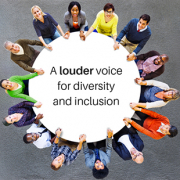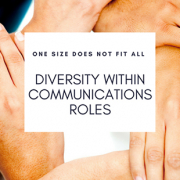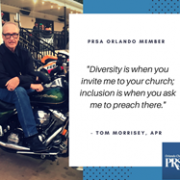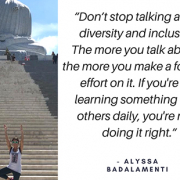Diversity and inclusion must be business-driven to be successful
By Alyssa Badalamenti, PRSA Diversity and Inclusion Chair
“If enhancing diversity and inclusion is not for the right thing, then do it for the business case,” said Deloria Nelson, President of Authentic Culture & Engagement Solutions.
Nelson consults with Fortune 500 companies on how to better their diversity and inclusion goals by developing customized workforce solutions for their teams. She likes to give company leaders the business case for why engaging diversity and inclusion matters—not just for people, but also for bolstering the company’s productivity, performance, and bottom line.
Once an executive team understands the business case, the Human Resources department typically takes the reins. But it takes more than implementing a new hiring policy to become a company with an inclusive culture.
“Diversity and inclusion in the workplace should be business-driven and integrated in the business culture, not just a standalone HR initiative,” Nelson said. “CEO support and transparency are critical to creating longevity and stickiness in company culture because it drives accountability and credibility.”
Nelson recently spoke to members of the Florida Diversity Council at its May program, sharing plenty of statistics and examples of how engaging in these practices will keep your company at pace with evolving needs for better workplace practices.
“We are living in a political era in which more companies are determining that they need to improve their diversity and inclusion efforts,” she explained. “But it is not political; it is a people thing.”
Nelson says it’s okay to be vulnerable when making decisions in diversity and inclusion engagement, as long you’re sincerely trying.
“Just be willing to take the risk—even if you make missteps along the way,” she advised.
She does, of course, recommend some important guidelines. Keep in mind this advice when evaluating your organization’s diversity and inclusion efforts.
Be aware of unconscious bias
Write objective skill sets in job postings and take a deep look at your words, phrases, and sentences that may be biased. Ensure there is a diverse slate of candidates interviewed by a diverse hiring panel. Diversity officers at the company are great, but how can one person define diversity and inclusion? Look at your leaders, too. Notice that representation is typically minimized as you move up in leadership positions. Be sure to give adequate support, tools, and resources equally for deserving individuals to progress at the company.
Be careful with “culture fit”
What does your office culture really mean? In our minds, we struggle with reconciling a new image of an old position. Be careful with “culture fit”—culture should evolve to let more people in it. Instead of looking for a “culture fit,” look for a “culture add,” or a candidate who will bring diverse opinions and experiences to the company’s culture.
Set goals and be humble
Balance strategy and tactics to keep people engaged. Be strategic, but don’t be so strategic that no one knows what you’re doing. Ensure you provide transparency, have CEO support, and have a “champion.” There’s no one way to do it right, but any movements, even baby steps, will take you in the right direction. But don’t toot your horn just because you’re better than you were before. The goal should be forward improvement, not to compare to others, or to compare to your lack of progress in the past.
Be yourself and learn from others
Don’t wear a mask! Think about how much energy it takes to be someone else at work just to fit in. And on the other side, learn from others. Don’t say things about someone’s culture without actually getting to know someone in the culture. Remember that we have more in common than we have differences. With proper relationships, you can avoid a diversity and inclusion crisis. When you prioritize inclusion, diversity will happen naturally because people enjoy working where they feel included.
Why isn’t it working?
If your company culture has not changed after implementing new practices, understand why. Nelson says it’s typically because of one or more of the following factors: fear of change, privilege, traditions, culture fit, loss of culture, or “sacred cows”—an idea or custom held (unreasonably) because it’s been ingrained in the company for a long time. There are often psychological and system barriers in place that can hurt behavioral change. Don’t be afraid of removing them.
One thing you can do immediately is make it mandatory to diversify candidate slates.
“It’s just like online dating,” Nelson explained. “When you open your scope of exposure, you open your culture to diversity.”
The Florida Diversity Council is a nonprofit organization that serves as a resource for diversity best practices and leadership development in Florida. The May program was part of a monthly series of events with the goal to influence leaders in the Central Florida community on what it truly means to engage diversity within company leadership.
PRSA Orlando’s Diversity and Inclusion Committee attended the program to be able to share key takeaways with chapter members, and learn how to incorporate Nelson’s advice within the public relations industry.











